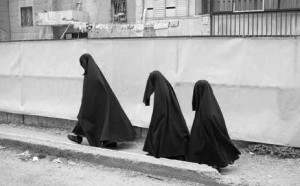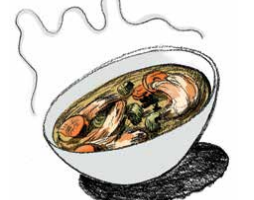Veiled Women on Display

A woman and her daughters wearing cloaks with
veils. Mea Shearim, Jerusalem, 2015.
The veiled and shrouded woman, covered head to toe in black, her cape dragging in the wet road, could well be a medieval leper. Perhaps under her layers of clothing she carries a bell to warn the unwary.
But no—one of the two women watching her—both in modest Mea Shearim, Jerusalem, dress—seems to be snapping this veiled woman’s picture with a cell phone.
This photo is among the most disturbing in “Veiled Women in the Holy Land,” at the Israel Museum in Jerusalem through February 29, 2020. The show offers more questions than answers on “New Trends in Modest Dress.”
Photos and mannequins of these Jewish “modesty women” and their Muslim sisters are on display along with their cloistered sisters—Catholic, Greek and Russian Orthodox nuns with ceremonial habits of up to eight layers going back to the 4th century. The cloistered nuns’ garments symbolize their chastity and spiritual marriage to Jesus Christ, but the retreat behind layers of clothing among some 100 ultra-Orthodox women in Jerusalem, and unknown numbers in other cities, started in the last 20 years and is less easily explained.
The most extreme of the Jewish women, many of them newly religious, don eight layers of clothing, the number worn by the High Priest in the days of the Temple. Their trailing capes may symbolize Sarah’s tent or, even more daring, the tent of meeting Moses erected for God, whose presence was known by a pillar of smoke.
The veil covering the face protects the wearer from temptation or evil impulses finding their way in. Reasons for wearers’ extreme modesty vary but include speeding not only their own redemption but that of the Jewish people in the next life. Is this chutzpah or madness or selfless modesty in a time of plunging necklines and skimpy skirts?
The increased layers worn by the Muslim women seem more grounded. The exhibit suggests the return to pre-British Mandate dress with veils and long garments symbolizing a new pious defiance of secular permissiveness and life under occupation.
At Israel-Palestine checkpoints, Israeli soldiers mistake Greek Orthodox nuns for Muslims. Elsewhere, Jewish modesty women are mistaken for Russian Orthodox nuns. While one modesty woman is quoted as saying, “You need to be willing to let go of what the eye can see,” this disquieting exhibit gives no hint of ecumenical sisterhood under the layers.
This summer, Lili Almog, an Israeli artist based in New York, poses covered, black-veiled women in private space and out in nature. The description for “Watershed Moments,” the traveling exhibit from the 2017 Jerusalem Biennale “Watershed” (at the Marlene Meyerson JCC Manhattan through August 14), draws the connection to Islamic burqas. But what about the more extreme “Jewish modesty women” at the Israel Museum? Is Almog picking up on a defiant trend?




